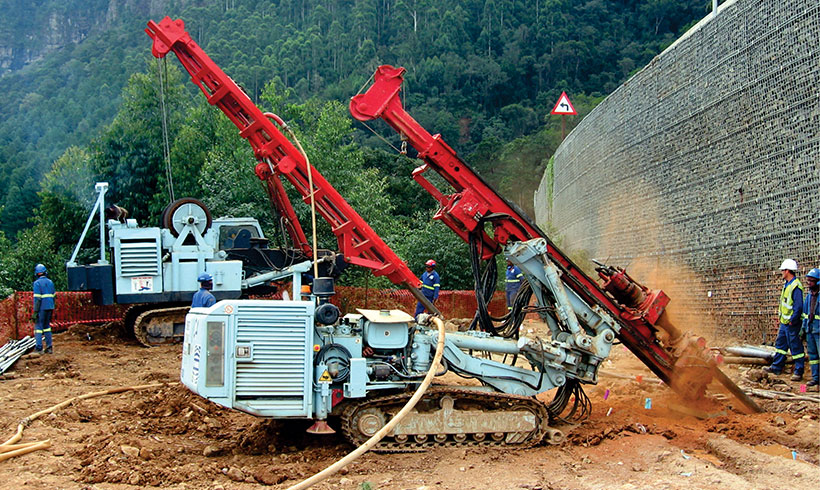The Basic Principles Of Geotechnical Engineering For Construction Projects
The Basic Principles Of Geotechnical Engineering For Construction Projects
Blog Article
Our Geotechnical Engineering For Construction Projects Statements
Table of ContentsNot known Details About Geotechnical Engineering For Construction Projects Geotechnical Engineering For Construction Projects for DummiesSome Known Incorrect Statements About Geotechnical Engineering For Construction Projects What Does Geotechnical Engineering For Construction Projects Mean?Geotechnical Engineering For Construction Projects for Beginners
During the examination, it is essential to drill at the called for deepness and the called for number of openings as per the referral of the Canadian Structure Style criterion. Often, the owner could save some Geotechnical Examination cost however wind up spending greater than the prepared for during the construction expense.The duties of the geotechnical expert entail giving material testing for building support. Geotechnical Engineering for Construction Projects. Geotechnical engineers evaluate all the area examination records to guarantee that building and construction is taking place based on the job requirements. During construction, a confirmatory test for dirt compaction is done on-site to make certain that no future negotiation occurs
After the concrete is put -7 days and 28 days- tests are carried out on concrete samples gathered from the site to guarantee that the concrete put fulfills the layout standard. Asphalt core is taken after the Asphalt is laid and compacted to validate that it satisfies the design criterion. All research laboratory examination records are evaluated by the Geotechnical Engineer to guarantee that it satisfies the job requirements.
Geotechnical Engineering For Construction Projects Fundamentals Explained

Geotechnical engineering plays an essential role in making certain the stability of construction projects. Geotechnical engineering is an essential branch of civil design that focuses on comprehending the behavior of planet products, such as dirt and rock.

For a reliable foundation and a smooth building and construction process, depend supply the competence you require. Call to get specialist guidance and geotechnical services tailored to your next job.
The Single Strategy To Use For Geotechnical Engineering For Construction Projects
When starting a land advancement job, comprehending the ground below your feet is as critical as the frameworks you intend to develop above it. Our Geotechnical Engineering team evaluate the ground, guaranteeing it is suitable for the recommended development while supplying you with the information needed to meet your job objectives.
Geotechnical Engineering looks at the formation of the ground, as it is the foundation for all jobs. Where frameworks require to be made with regard to the ground problems; ground problems (e.g., soft ground) may require enhancing depending upon the size of the designated structure. Before building, you require to learn about the groundwater, soil framework, and liquefaction possibility of your land.
For websites that are not linked on the local authority facilities additional site examinations would be needed to give technical inputs for on-site stormwater and wastewater. We have experienced Geotechnical Engineers based in each workplace, sustaining your geotechnical needs nationwide. Get to out to us to discuss how we can sustain your next task.
These records are tailored to meet the certain demands of a project and consist of layout specifications and suggestions for the building of a variety of manufactured structures. As giving working as a consultant services covering locations such as slope security and load-bearing capabilities for various materials, these engineers undertake study and growth tasks to improve methods, tools, products understanding and evaluation covering entire lifecycles.
Indicators on Geotechnical Engineering For Construction Projects You Should Know

However, prices of pay typically enhance as your knowledge and skills expand, with standards directing to a graduate beginning salary of between 18,000 and 28,000 each year in the UK. This increases to 26,000 to 36,000 with a few years of experience and afterwards getting to 40,000 to 60,000+ for elderly, legal or master designers.
Nonetheless, with the best application it is possible to master the occupation and gain entrance to a challenging yet satisfying and essential profession. A rock hound would require to re-train to end up being a geotechnical designer, although there is lots of cross-over between the 2 careers, which can make this less complicated - Geotechnical Engineering for Construction Projects. Rock hounds need to have an understanding of soils, rocks and other products from a scientific point of view, while geotechnical engineers story their expertise of issues such as dirt and rock technician, geophysics and hydrology and use them to engineering and ecological projects
When starting, these designers will tend to deal Bonuses with less complex tasks, developing understanding and experience all set for more tough work later on. check Geotechnical engineers tend to specialise in certain locations as they grow in experience, focusing on certain facilities such as railways, roadways or water. These engineers also deal with renewable resource, offshore and onshore oil and gas, nuclear power, and a lot more.
The Basic Principles Of Geotechnical Engineering For Construction Projects
The time required to come to be a geotechnical designer depends on where you are based, where you research and what degree of education you intend to obtain before getting in the office. Are you going to check out an apprenticeship, take an university level or work with towards a Master's or PhD? Generally-speaking it takes 3-4 years to reach the basic requirements to begin an occupation as a geotechnical engineer.
These procedures make it possible for professionals to examine a host of soil auto mechanics including weight, porosity, void-to-solid bit ratio, permeability, compressibility, optimum shear strength, birthing capability and deformations. If the structure calls for a deep structure, engineers will certainly use a cone infiltration test to approximate the amount of skin and end bearing resistance in the subsurface.
When examining a slope's balance of shear stress and shear toughness, or its capacity to endure and undergo motion, rotational slides and translational slides are frequently taken into consideration. Rotational slides fail along a bent surface area, with translational slides occurring on a planar surface area. A specialist's goal is to figure out the conditions at which a slope failing might happen.
Typically, findings recommend that a site's dirt must sites be treated to enhance its shear toughness, tightness and permeability before design and building. When it comes time to lay out structure strategies, professionals are significantly concentrated on sustainability, even more specifically how to minimize a foundation's carbon impact. One strategy has actually been to change 20 percent of a foundation's concrete with fly ash, a waste product from coal fire nuclear power plant.
Report this page